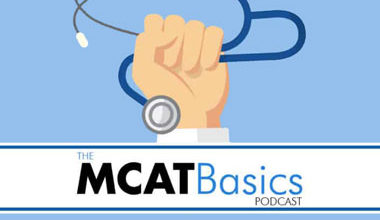-
MCAT Basics Podcast
Adenosine Triphosphate or ATP
In this episode, we’ll talk about ATP or adenosine triphosphate. We will begin with a detailed examination of ATP’s structure and composition as a nucleotide, followed by an explanation of the metabolic pathways involved in its production—both aerobic and anaerobic.…
Read More » -
MCAT Basics Podcast
Redox Reactions: Reduction and Oxidation
Redox reactions or reduction and oxidation are reactions in which electrons are simultaneously transferred from one chemical species to another. This episode begins with exploring this concept, including an in-depth look at oxidizing and reducing agents and the factors determining…
Read More » -
MCAT Basics Podcast
Sound and Hearing
In this episode, we focus on the physiology of sound and hearing. We begin by exploring sound-related concepts, including sound waves, pitch, ultrasound, and the decibel system. Next, we delve into the anatomy and physiology of the ear, providing a…
Read More » -
MCAT Basics Podcast
Fluid Statics
This MCAT Basics episode covers fluid statics (fluids standing still). It begins with different fluid properties, including surface tension, vapor pressure, adsorption and absorption, adhesion and cohesion, and Henry’s law. Next, it discusses several important fluid statics concepts: static fluid…
Read More » -
MCAT Basics Podcast
The Muscular System
This MCAT BAsics episode covers the muscular system. It begins with the differences and similarities between the three types of muscle (smooth, cardiac, and skeletal). Then, the podcast explores the basic structure of a skeletal muscle cell and the various…
Read More » -
MCAT Basics Podcast
Social Stratification
This MCAT podcast covers social stratification. It begins with a definition and examples of many terms related to social stratification and inequality, including prejudice, discrimination, stereotype, stereotype threat, status (ascribed vs achieved), power (six different types to know), social capital…
Read More » -
MCAT Basics Podcast
Classic Psychology Experiments
In this episode, we delve into classic psychology experiments –relevant to the Psych/Soc section of the MCAT. We cover a range of significant studies, including Pavlov’s Dog, Harlow’s Monkey Study, Albert’s Bobo Doll Experiment, the Skinner Box Experiment, Asch’s Conformity…
Read More » -
MCAT Basics Podcast
The Cell Cycle
In this episode, we explore the different phases of the cell cycle: Interphase (G1, S, G2) and the M phase (mitosis). Next, we discuss the regulation of the cell cycle and the key checkpoints that ensure its proper progression. Finally,…
Read More » -
MCAT Basics Podcast
Isomers
In this episode, we delve into three common types of isomers that you are likely to encounter on the MCAT: structural isomers, geometric isomers, and stereoisomers. We start by defining each type of isomer, providing clear and concise explanations to…
Read More » -
MCAT Basics Podcast
Emotion and Motivation
In this episode, we cover motivation and emotion–key concepts that will show up in the Psychological, Social, and Biological Foundations of Behavior section of the MCAT. We start with the difference between intrinsic and extrinsic motivation. We then go into…
Read More »
